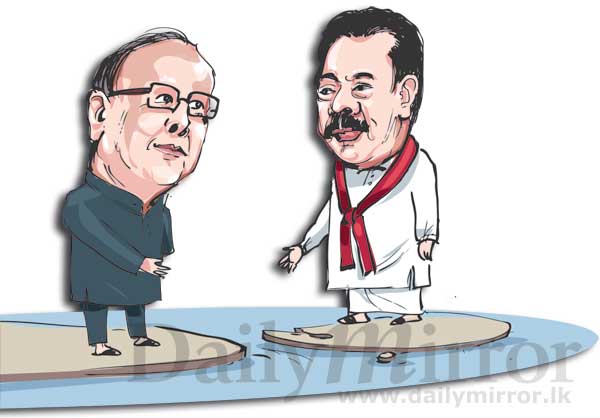Reply To:
Name - Reply Comment
 By N. Sathiya Moorthy
By N. Sathiya Moorthy
No debate or discourse in contemporary Sri Lanka or on Sri Lanka will be complete without a reference to India. Depending on the issue, like the ‘national problem’, strategic security or economy, ‘factors’ such as Tamil Nadu, China or aid get a reference. The same can be said about India’s equations with its neighbours, where Sri Lanka gets more than a brief mention. This has been so despite India’s intractable issues involving Pakistan and/or China. This was so in the past, it will remain so in the future.
India is a fact that the Sri Lankan State has learnt to live with – and, work with, too. There are differences under every head, but they are not as insurmountable as some people in the two countries would want to believe, and want the rest of their countrymen to believe, too. That has been the problem. As events of the past years unfolded, there has been greater understanding in India’s policy-making circles on issues of mutual concerns and about elements causing those concerns than in the nation’s strategic community. The reverse is not always true.
It is not without reason. Given the size of their populations, armed forces and economy – and not in that order, relative influences and/or dependence on the global scene, India is also a pre-occupation for most Sri Lankans. Ethnicity and the ethnic issue does not measure in those term in defining or re-defining bilateral relations, though it is a component, nonetheless. The average Indian’s pre-occupation lies elsewhere. It is also why the constant criticism of Sri Lanka in a State like Tamil Nadu always does not attract national or nation-level resonance in rest of India.
It is inevitable that the strategic community in Sri Lanka is still tempered by their experience from the past. They harp on India aiding and assisting the Tamil militant youth in the Eighties, little acknowledging the reversed role through ‘Eelam War-IV’. It was true of the early Seventies, at the height of the ‘First JVP insurgency’. If linked to the subsequent Sri Lankan refuelling facility for the Pakistan Air Force at the height of the ‘Bangladesh War’ only six months later in December 1971, New Delhi would not have signed off the strategic Kachchativu islet, despite political protests from Tamil Nadu, only three years later.
It may be convenient to argue that the Indo-Sri Lanka Accord and the IPKF presence in 1987 contributed to the ‘Second JVP insurgency’ but to believe that the ‘Sinhala-nationalist’ movement would not have taken the same leftist militant turn at the time, even otherwise is an under-statement . The IPKF presence released the Sri Lankan defence forces for the defence of the ‘Sinhala South’. It is unfortunate that no one in Sri Lanka, now as then, wants to talk about the butchering of thousands of Sinhala youth at the time, at the hands of the armed forces. Left militancy, even of the ethnic nationalist variety, does not produce resonance in global capitals as many others.
It is unthinkable that the Indian commanders on the ground did not understand what use they were being put to, by the Sri Lankan State at the time – defending the northern and eastern territory from the LTTE. Later still, they also understood how the Government of the day was aiding and arming the LTTE to fight the IPKF, which was called in to defend Sri Lankan territory. When the IPKF left, Sri Lankan territory or sovereignty was not compromised in anyway.

India and the IPKF respected Sri Lankan sovereignty. After sacrificing over a thousand men in Sri Lankan jungles, “fighting (the LTTE enemy of the Sri Lankan State) with their hands tied to their back”, and silently suffering the blame for atrocities attributed to the IPKF, New Delhi pulled out its armed forces without question when Colombo desired so. At the height of ‘Eelam War-IV’, the Indian army sent medical teams without military security, to serve the very same Tamil civilians caught in the cross-fire. No one said ‘Sorry’ to anyone – from the Government or the Tamils. Yet, they readily expected New Delhi to back Colombo on the HR front, both during the war and after the war. India obliged to a very great extent, until the Geneva vote earlier this year.
The ‘ethnic issue’ is a factor in bilateral relations between India and Sri Lanka. It has become a factor also in Sri Lanka’s relations with other countries. The ‘with-me-or-against-me’ syndrome fits the bill. That used to be the line taken by the Tamil leadership, moderate or militant, war or no war. To the list, the Government has added its favourites, through the war and afterward, too. The Sri Lankan State had every right to expect other State actors to act responsibly in tackling terrorism. Others too had expectations from the Sri Lankan State in addressing the issues that caused terrorism in the first place.
Post-9/11 comparisons suffered from two infirmities. One, the situations were dis-similar after a point. Two, the world was demanding from Sri Lanka what it had promised them in the first place – a negotiated settlement to the ethnic issue. Colombo did not talk about processes and procedures while seeking their help and cooperation in finishing off the LTTE. If anything, it was talking about talks, a solution through the APRC or whatever. Yet, it would be wrong to confuse the APRC Report to the leaked ‘Minority Report’ of the time. The latter was an internal, working document.
While helping to finish off the LTTE, the international community was fobbing off the LTTE. Next only to jihadi terrorism world-wide, the ‘Sri Lankan ethnic issue’ has possibly the greatest resonance in countries and communities across the continents. The methodology did not fit into definitions of ‘terrorism’ as local laws and court rulings commanded. In Australia, the LTTE was/is not a banned outfit. In India, the Supreme Court ruled that the ‘Rajiv Gandhi assassination’ was not an ‘act of terror’ under the special law of the day.
Yet, the political issues, the war-end political protests in global capitals and elsewhere were for real. By urging Sri Lanka to find a political solution to the ethnic issue, the international community was asking it to ensure that they did not have another international problem in their hands – after the even more emotive ‘Palestine problem’, with which they have learnt to live with since the Second World War. No one is talking about Palestine now. They are talking about ‘jehadi’, instead.
_DM-9_02.jpg) Yet, the western world does not understand either, for them to empathise with. To most of them on the streets of western nations, simplifying problems before them makes them easy to accept. The solutions too could only be simplistic. Taking the complexities in doses, they often end up throwing up their hands and leaving in distress. From Vietnam to Afghanistan, Shah’s Iran to Marcos’ Philippines, there is a pattern, unintended or otherwise. None seem to be thinking or about the ‘day after’ when they should be.
Yet, the western world does not understand either, for them to empathise with. To most of them on the streets of western nations, simplifying problems before them makes them easy to accept. The solutions too could only be simplistic. Taking the complexities in doses, they often end up throwing up their hands and leaving in distress. From Vietnam to Afghanistan, Shah’s Iran to Marcos’ Philippines, there is a pattern, unintended or otherwise. None seem to be thinking or about the ‘day after’ when they should be.
The ethnic issue is a factor in India-Sri Lanka relations. It is not the only factor. The solution to the problem lies within Sri Lanka. When the consequences defy national borders, India became concerned – and involved. Long before trickles of ‘boat people’ began crossing across continents as ‘economic refugees’, post-war, India was house to 250,000 men, women and children, shattered and stuck. The long saga has had its vagaries. With the end of the war, the plight has to end. It goes beyond the ‘Tamil Nadu factor’. It may have included the demographic imbalances any integration of the refugees with the local communities might have entailed. India’s experience with the ‘Bangladeshi refugees’ who would not go back was a lesson for New Delhi.
Parliamentary discussions and disturbances in India witnessed during the run-up to the Geneva vote this year were an expression of concern that went beyond Tamil Nadu. It is not about who is ruling from India. The ‘Geneva vote’ showed as much. It also showed that the Indian concerns on the ethnic issue was not linked to – and could not be linked to – the ‘China factor’. The latter was a trade-off some Sri Lankan strategic thinkers had thought would keep India eternally on Colombo’s side on the ethnic issue. To Indians, LTTE terrorism was one thing, the ‘ethnic issue’ was another. The former having been resolved, the latter could not wait beyond a point.
The Sri Lankan Government alone is not to blame for the delays in finding a negotiated settlement. The decades-old history of the ethnic issue is a baggage all Governments in Colombo have carried forward and passed on to the successor. The intransigence of the Tamils, moderates and militants alike, did not help, either. Throughout these decades, the Tamil moderates were also confused about their goals and processes. With bare hands, they were fighting with extremists on both sides. They had lost out to the others in the past. Post-Geneva, there is nothing to indicate that they would not lose again, now.
It is not about human rights. It is more about a political solution. The Tamil moderates need one to stay relevant – now and into future generations. They have problem acknowledging their inherent and institutional weaknesses, but the alternative for the Tamil people and the nation as a whole is to sink into the abyss all over again. The Tamils do not want it. Sri Lanka does not need it. The world cannot have it.
The writing on the wall is clear. Resolve or perish. It’s ‘heads’ you win, ‘tails’, I lose! Sri Lanka can do without it – now and ever.